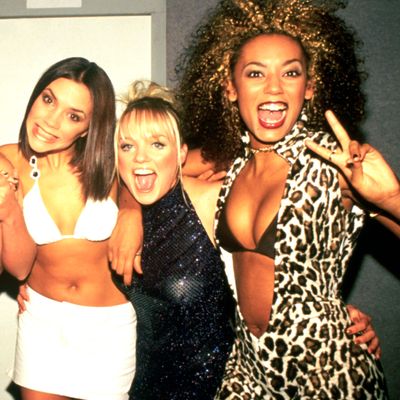
It’s tempting to blame my parents for the fact that I never saw Spice World. When the Spice Girls’ critically lambasted, box-office-smashing, music-video movie arrived in American theaters in January 1998, I was a second-grader, and at my house, the Spice Girls were strictly off-limits for me and for my teenage brother. “It’s not even just the bare boobs that I object to,” I overheard my mom say on the phone once to a friend from church. Then she looked at me, said into the phone, “Oh, didn’t realize I had an audience,” and shooed me out of the laundry room.
Twenty years later, on the film’s anniversary, I remain mystified by the phenomenon that Spice Girl Mania was. Before I watched Spice World for the first time, last week, I quizzed myself: Could I accurately come up with the real names, even just the first names, of all the Spice Girls? I couldn’t, though it turns out two of them, unfairly, are named Mel. So the subsequent 93 minutes I spent getting to know the Spice Girls were an adventure; a fun, sometimes frustrating, other times deeply bizarre adventure, and one in which I discovered that Spice World makes more relevant, resonant points in 2018 than it did in 1998.
Spice World’s meandering plot follows the five singers in the days leading up to their massive, globally broadcast concert at London’s Royal Albert Hall. In one opening scene, the girls are annoyed when their manager corrals them back into rehearsal and decrees there’s no more room in their schedule for them to hang out with their old friend Nicola, who’s approximately 11 months pregnant. From there, the pressures from their manager, their label, their tour, and the media only mount. Their frustrations pile up until the girls angrily bunk off from their rehearsal on the eve of the Royal Albert show, leaving their show all but canceled and their band all but dissolved until they conveniently remember how much they love being in a band together and speed back to Royal Albert Hall in their famous Union Jack–emblazoned tour bus (which, naturally, can fly, and they of course help deliver Nicola’s baby on the way).
As most critics wrote at the time of its release, the plot is indeed very silly, and the acting very bad. Janet Maslin wrote in her review for the New York Times that while Spice World has “only the barest semblance of a story line” and is mainly “just a showcase for the Girls’ hits, clothes, hairdos and lollipops,” it’s a harmless, often amusing one at that. Viewed 20 years after its release, though, Spice World seems … well, not quite “ahead of its time,” since it’s hard to argue there’s ever a right moment for a lazily written, thinly veiled cash grab of a movie to arrive in cinemas. But one does get the sneaking feeling Spice World arrived at a particularly wrong moment when it initially premiered Stateside.
Released in January of 1998, Spice World paid dubious lip service to the 1990’s third-wave feminism and the so-called “lipstick” feminists of the era: It seemed to want to say that objectification was in the eye of the beholder, and that just because the Spice Girls enjoyed looking sexy and feminine didn’t mean they were dumb or unworthy of being treated as full, autonomous human beings. Unfortunately, for all its shrieks of “girl power!”, it also drove home that the Spice Girls were, in fact, dumb. Victoria Beckham’s Posh Spice doesn’t pick up on a joke at her expense about her inability to decide which of her identical tiny black Gucci dresses to wear. A game of chess between two Spice Girls (!) devolves into an infantile squabble about why the game’s rules even matter (“Says who?” “Says … Mr. Chess! It’s been in the rules for thousands of years!”). Even when Geri Halliwell’s Ginger Spice is seen explaining to a man in a club that it’s okay and even a positive thing for a man to be intimidated by a woman’s success, she becomes the butt of the joke when she fails to notice that the man himself is intimidated and uncomfortable talking to her. The movie both promoted and consistently undercut the notion that these girls were more than just pretty faces, and ultimately, Roger Ebert wrote in one of his more venomous pans that “The Spice Girls have no personalities; their bodies are carriers for inane chatter.”
Revisited in 2018, though, it’s oddly poignant. Here in the time of #MeToo, bad male behavior and its consequences for women is one of the causes célèbres of “fourth-wave” feminism; movements like #YesAllWomen and the rise of the term “mansplaining” point a finger at men wasting women’s time, harming them emotionally and physically, and generally impeding them from living their lives as they please. Spice World, in that sense, presents a central conflict that feels somewhat relevant to right now: Five young women have the audacity to demand that their needs and wants — and success — be taken seriously, and the constant interference from bad men very nearly costs them their livelihood. The plot of Spice World, weakly Scotch-taped together as it may be, finds the band repeatedly trying to escape from men’s schemes that range from opportunist to downright evil. There’s the wannabe-auteur documentarian who annoys them, the creepy paparazzo who stalks them and records their interactions without their consent, the feature filmmaking duo who want to profit off their popularity, the manager who wants to control every moment of their time, and the record label exec who … well, strokes a cat and then later a pig while feeding vaguely nefarious, supremely ridiculous guidance to the manager over the phone. It’s unclear, actually, what that last guy is up to. But we’re generally meant to understand that he too stands in the way of the girls’ freedom to own their time and their fame. (Roger Moore in this role, for what it’s worth, is a joy.)
Spice World does contain more boobs, boob jokes, and sex jokes than I would have expected a movie marketed to children to contain in the 1990s; my mom was right about that. That said, Spice World also contains more normalized single motherhood, more criticism of how the media often pigeonholes women into oversimplified and one-dimensional personas, and more frank acknowledgments of the fleeting nature of commercial stardom than I would have expected, too. It’s a strange experiment, to be sure — but perhaps in a time when critics and audiences had developed (a little) more appreciation for the importance of stories about women just trying to live their lives without bad men interfering, it may have have fared better.
Or it may not have. Twenty years later, “Tonight is the night when three become one” remains an unforgivable thing to witness.




